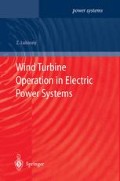Abstract
The connection of the wind turbine generator system to parallel operation with the electric power system influences the system state (operating point) and influences the load flow (real and reactive power). At the same time, nodal voltages and power losses themselves change, too. These quantities, defining the electric power system state, can be assumed to be basic but in fact the spectrum of factors influencing the electric power system as a result of the WTGS connection to the grid is much wider. The factors, which are considered in the following sections in a more detailed form, can be generally characterized as follows:
-
•
Location of the wind turbine in the electric power system. The way of connecting it to the electric power system (which in general is an AC system) highly influences the impact of the WTGS (or wind farm) on the power quality. As a rule, the impact on power quality at the consumer’s terminal for the WTGS located close to the load (i.e. connected to an MV system) is higher than one connected “electrically” far away (i.e. connected to an HV or EHV system).
-
•
Voltage variations of amplitude and frequency. The variations mainly result from the wind velocity, but other factors influencing the generator torque play an important part, too. Voltage variations are directly related to real and reactive power variations. The WTGSs equipped with an asynchronous generator with a squirrel-cage rotor or with a resistor connected to the rotor (in woundedrotor machines) are consumers of reactive power, which can cause additional negative problems for the grid.
Access this chapter
Tax calculation will be finalised at checkout
Purchases are for personal use only
Preview
Unable to display preview. Download preview PDF.
Reference
Of course, improperly developed control systems of WTGSs can decrease the natural — for asynchronous generators — high damping of any electromechanical oscillations.
This is a simplification only.Power losses are considered in Sect. 4.8.
The power generated by WTGS, i.e. Swtgs =-Pwtgs +j Qwtgs can be also considered as a change of power generated by the wind turbine during its operation.
The maximum power change will take place after disconnecting the fully loaded wind turbine from the power system.
The above considerations pertain to an extremely simple power network. In general, these considerations can be treated the WTGS to the network, the power losses in the last branch decrease, then the power losses in the remaining branches of the radial network (when all the loads are inductive) also decrease, which can be treated as a positive feature.
The above values are relatively small but it is worth remembering that the decrease
Power losses in other branches of the system can be similar. Then the total decrease of the power losses will be higher.
The characteristic presented in Fig.6.3 and its extrapolation (above 0.9 MW) is used here.
Because modern WTGSs operate with power factor less than 0.3, this case is not realistic.
the MV power network? Let us consider the overhead MV transmission line with the cross-sectional area of conductor s = 120 mm
An increase of the power generated by the WTGS, for example to 2 MW, causes a decrease of the power losses to about 0.5, which means 66 kW generated by the WTGS (for which the decrease of the power losses is obtained) can be achieved for the fully compensated WTGS (QwTGS = 0).
As an example of the above considerations, Fig. 4.27 presents the level of power loss decrease as a function of various values of the load and WTGS power factors tançpl, tamp WIGS
In the case of WTGS analysis, power variations at maximum can be assumed as equal to the wind turbine rated power . Inpractice, when evaluating flicker, power variations within 95% of the maximum variation band corresponding to a standard deviation are evaluated.
The standard does not cover voltage changes less frequent than one per day.
IEC 61000–21 standard suggests using values when the data are unknown. For high-rated power modern wind turbines the values are too high.
These are values typical for present day WTGSs.
The variables in Tables 4.8 and 4.9 are defined in the following pages.
The wind turbine should be taken into consideration when, or are satified.
The impedances in the example are calculated at the MV power system voltage level the level at the point of common coupling of the wind turbine generator system with the power system.
Estimation of the error related to neglecting the resistance is presented later in this section.
It is worth remembering that the origin of the conditions is mainly related to the power quality problem.
Author information
Authors and Affiliations
Rights and permissions
Copyright information
© 2003 Springer-Verlag Berlin Heidelberg
About this chapter
Cite this chapter
Lubosny, Z. (2003). WTGS Operation in Power Systems. In: Wind Turbine Operation in Electric Power Systems. Power Systems. Springer, Berlin, Heidelberg. https://doi.org/10.1007/978-3-662-10944-1_4
Download citation
DOI: https://doi.org/10.1007/978-3-662-10944-1_4
Publisher Name: Springer, Berlin, Heidelberg
Print ISBN: 978-3-642-07317-5
Online ISBN: 978-3-662-10944-1
eBook Packages: Springer Book Archive

